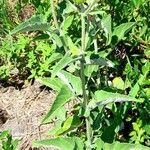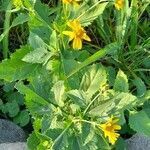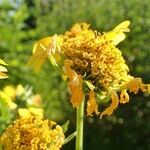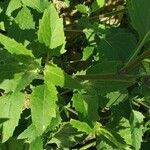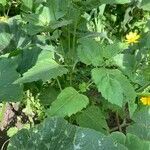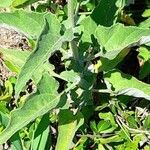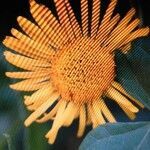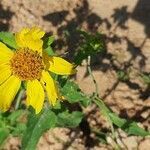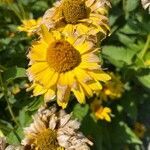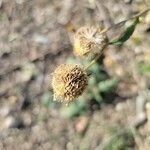Erect annual 2–10 dm, the stem and lower lf-surfaces strigose-canescent, the upper lf-surfaces sometimes greener but still strigose; lvs alternate (except the lower), ovate or deltoid, sometimes rather narrowly so, rather coarsely toothed, especially near the base, 4–13 × 2–10 cm; petiole well developed, commonly auriculate-dilated at base; heads long-pedunculate in an open infl, the disk 13–20 mm wide infl; invol bracts loose or a little spreading, scarcely imbricate, canescently strigose or hirsute; rays 10–15, pistillate, yellow, evidently trilobed, 1–1.5 cm; achenes winged, a little spreading but not reflexed, the fruiting head hemispheric; 2n=34. Open, often waste places; native of Mex. and sw. U.S., casually intr. with us, especially westward. May–Oct. (Ximenesia e.; X. exauriculata) Ours is var. encelioides.
Plants 10–50(–120+) cm (annuals, internodes not winged). Leaves all or mostly alternate (proximal usually opposite); blades deltate-ovate or rhombic to lanceolate, 3–8(–12+) × 2–4(–6+) cm, bases broadly cuneate to ± truncate, margins coarsely toothed to subentire, apices acute to attenuate, faces strigoso-scabrellous to sericeous. Heads usually borne singly, sometimes 2–3+ in loose, cymiform or corymbiform arrays. Involucres ± hemispheric to saucerlike, 10–20+ mm diam. Phyllaries 12–18+ in 1–2 series, ± erect to spreading, lance-ovate or lance-linear to linear, 6–8+ mm. Ray florets (8–)12–15+; laminae 8–10(–20+) mm. Disc florets 80–150+; corollas yellow. Cypselae dark brown to blackish, narrowly obovate, 3.5–5+ mm, faces ± strigillose; pappi 0.5–1(–2) mm (0 on ray cypselae). 2n = 34.
Annual herb, 0.5-1.0 m high; with ribbed and pilose branches. Leaves alternate, ovate, deeply toothed, pubescent on upper surface, densely white-tomentose beneath. Capitula radiate; many-flowered, peduncled, terminal and axillary, corymbose; involucre campanulate; bracts in 2 rows, lanceolate, strigose on back, herbaceous. Receptacle flat, paleate; paleae as long as ovary, lanceolate in profile, boat-shaped, acuminate, keeled, ciliate on keel, pilose above. Ray florets yellow; tube very much shorter than lamina, pilose; lamina broadly linear, obtuse. Disc florets bisexual, fertile; corolla yellow; tube pilose below. Anthers linear, faintly eared at base, with lanceolate apical appendage. Style terete, globose at base; branches linear. Pappus of 2 awns. Cypselae laterally compressed.
For description of subspecies occurring in Australia see Verbesina encelioides (Cav.) Benth. & Hook.f. ex A.Gray subsp. encelioides.
